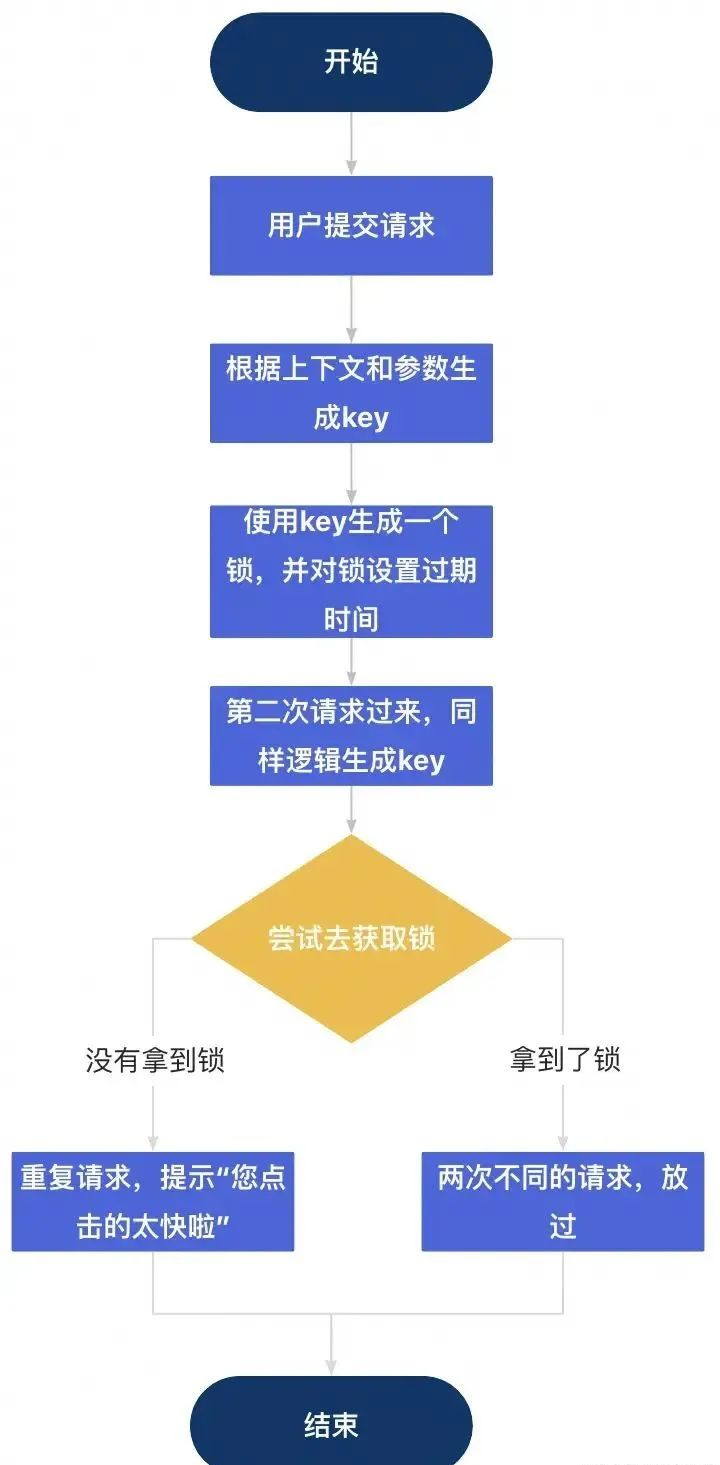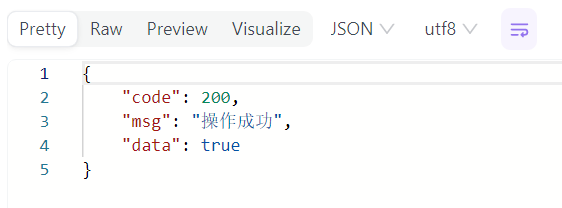
一、啥是防抖
所谓防抖,一是防用户手抖,二是防网络抖动。
在Web系统中,表单提交是一个非常常见的功能,如果不加控制,容易因为用户的误操作或网络延迟导致同一请求被发送多次,进而生成重复的数据记录。要针对用户的误操作,前端通常会实现按钮的loading状态,阻止用户进行多次点击。而对于网络波动造成的请求重发问题,仅靠前端是不行的。为此,后端也应实施相应的防抖逻辑,确保在网络波动的情况下不会接收并处理同一请求多次。
一个理想的防抖组件或机制,应该具备以下特点:
- 逻辑正确,也就是不能误判;
- 响应迅速,不能太慢;
- 易于集成,逻辑与业务解耦;
- 良好的用户反馈机制,比如提示“您点击的太快了”
二、思路解析
哪一类接口需要防抖?
接口防抖也不是每个接口都需要加,一般需要加防抖的接口有这几类:
- 用户输入类接口:比如搜索框输入、表单输入等,用户输入往往会频繁触发接口请求,但是每次触发并不一定需要立即发送请求,可以等待用户完成输入一段时间后再发送请求。
- 按钮点击类接口:比如提交表单、保存设置等,用户可能会频繁点击按钮,但是每次点击并不一定需要立即发送请求,可以等待用户停止点击一段时间后再发送请求。
- 滚动加载类接口:比如下拉刷新、上拉加载更多等,用户可能在滚动过程中频繁触发接口请求,但是每次触发并不一定需要立即发送请求,可以等待用户停止滚动一段时间后再发送请求。
如何确定接口是重复的?
防抖也即防重复提交,那么如何确定两次接口就是重复的呢?首先,我们需要给这两次接口的调用加一个时间间隔,大于这个时间间隔的一定不是重复提交;其次,两次请求提交的参数比对,不一定要全部参数,选择标识性强的参数即可;最后,如果想做的更好一点,还可以加一个请求地址的对比。
三、如何做接口防抖
适用于分布式部署服务的场景。
1. 使用共享缓存

2. 使用分布式锁
常见的分布式组件有Redis、Zookeeper等,但结合实际业务来看,一般都会选择Redis,因为Redis一般都是Web系统必备的组件,不需要额外搭建。

四、具体实现 - 基于springboot
4.1 请求锁
通过自定义注解@RequestLock,使用方式很简单,把这个注解加在接口方法上即可。
@RequestLock注解定义了几个基础的属性,redis锁前缀、redis锁时间、redis锁时间单位、key分隔符。
其中前面三个参数比较好理解,都是一个锁的基本信息。
key分隔符是用来将多个参数合并在一起的,比如userName是张三,userPhone是123456,那么完整的key就是”张三&123456”,最后再加上redis锁前缀,就组成了一个唯一key。
1
2
3
4
5
6
7
8
9
10
11
12
13
14
15
16
17
18
19
20
21
22
23
24
25
26
27
28
29
30
31
32
33
34
35
36
37
38
39
40
41
42
43
44
| import java.lang.annotation.Documented;
import java.lang.annotation.ElementType;
import java.lang.annotation.Inherited;
import java.lang.annotation.Retention;
import java.lang.annotation.RetentionPolicy;
import java.lang.annotation.Target;
import java.util.concurrent.TimeUnit;
@Target(ElementType.METHOD)
@Retention(RetentionPolicy.RUNTIME)
@Documented
@Inherited
public @interface RequestLock {
String prefix() default "";
int expire() default 2;
TimeUnit timeUnit() default TimeUnit.SECONDS;
String delimiter() default "&";
}
|
eg:
1
2
3
4
5
6
| @PostMapping
@RequestLock(prefix = "agreement", expire = 5)
public R<Boolean> add(@RequestBody Agreement agreement) {
return R.success(agreementService.save(agreement));
}
|
4.2 唯一key生成
那直接拿参数来生成key不就行了吗?不是不行,但:如果这个接口是文章发布的接口,你也打算把内容当做key吗?要知道,Redis的效率跟key的大小息息相关。所以,最好是选取合适的字段作为key就行了,没必要全都加上。
要做到参数可选,就使用该 @RequestKeyParam 注解加在入参参数前 或 实体类中的字段上:
1
2
3
4
5
6
7
8
9
10
11
12
| import java.lang.annotation.*;
@Target({ElementType.METHOD, ElementType.PARAMETER, ElementType.FIELD})
@Retention(RetentionPolicy.RUNTIME)
@Documented
@Inherited
public @interface RequestKeyParam {
}
|
这个注解加到参数上就行,没有多余的属性。
eg:
1
2
3
4
5
6
7
8
9
10
11
12
13
14
15
16
17
18
19
20
21
22
23
| @Data
@NoArgsConstructor
@AllArgsConstructor
@ApiModel("协议")
public class Agreement {
@ApiModelProperty("协议名称")
@RequestKeyParam
private String name;
@ApiModelProperty("所属分类")
@RequestKeyParam
private Long type;
}
|
接下来就是lockKey的生成了:
1
2
3
4
5
6
7
8
9
10
11
12
13
14
15
16
17
18
19
20
21
22
23
24
25
26
27
28
29
30
31
32
33
34
35
36
37
38
39
40
41
42
43
44
45
46
47
48
49
50
51
52
53
54
55
56
57
58
59
60
61
62
63
64
65
66
67
| import com.ruoyi.common.annotation.RequestKeyParam;
import com.ruoyi.common.annotation.RequestLock;
import com.ruoyi.common.utils.StringUtils;
import org.aspectj.lang.ProceedingJoinPoint;
import org.aspectj.lang.reflect.MethodSignature;
import org.springframework.util.ReflectionUtils;
import java.lang.annotation.Annotation;
import java.lang.reflect.Field;
import java.lang.reflect.Method;
import java.lang.reflect.Parameter;
public class RequestKeyGenerator {
public static String getLockKey(ProceedingJoinPoint joinPoint) {
MethodSignature methodSignature = (MethodSignature) joinPoint.getSignature();
Method method = methodSignature.getMethod();
RequestLock requestLock = method.getAnnotation(RequestLock.class);
final Object[] args = joinPoint.getArgs();
final Parameter[] parameters = method.getParameters();
StringBuilder sb = new StringBuilder();
for (int i = 0; i < parameters.length; i++) {
final RequestKeyParam keyParam = parameters[i].getAnnotation(RequestKeyParam.class);
if (keyParam == null) {
continue;
}
sb.append(requestLock.delimiter()).append(args[i]);
}
if (StringUtils.isEmpty(sb.toString())) {
final Annotation[][] parameterAnnotations = method.getParameterAnnotations();
for (int i = 0; i < parameterAnnotations.length; i++) {
final Object object = args[i];
final Field[] fields = object.getClass().getDeclaredFields();
for (Field field : fields) {
final RequestKeyParam annotation = field.getAnnotation(RequestKeyParam.class);
if (annotation == null) {
continue;
}
field.setAccessible(true);
sb.append(requestLock.delimiter()).append(ReflectionUtils.getField(field, object));
}
}
}
return requestLock.prefix() + sb;
}
}
|
4.3 重复提交判断
1) redis 缓存方式
- AOP 切面:RedisRequestLockAspect
核心代码是stringRedisTemplate.execute里面的内容,正如注释里面说的“使用RedisCallback接口执行set命令,设置锁键;设置额外选项:过期时间和SET_IF_ABSENT选项”。
SET_IF_ABSENT是 RedisStringCommands.SetOption 枚举类中的一个选项,用于在执行 SET 命令时设置键值对的时候,如果键不存在则进行设置,如果键已经存在,则不进行设置。
1
2
3
4
5
6
7
8
9
10
11
12
13
14
15
16
17
18
19
20
21
22
23
24
25
26
27
28
29
30
31
32
33
34
35
36
37
38
39
40
41
42
43
44
45
46
47
48
49
50
51
52
53
54
55
56
57
| import com.ruoyi.common.annotation.RequestLock;
import com.ruoyi.common.exception.base.BaseException;
import com.ruoyi.common.utils.StringUtils;
import org.aspectj.lang.ProceedingJoinPoint;
import org.aspectj.lang.annotation.Around;
import org.aspectj.lang.annotation.Aspect;
import org.aspectj.lang.reflect.MethodSignature;
import org.springframework.beans.factory.annotation.Autowired;
import org.springframework.context.annotation.Configuration;
import org.springframework.core.annotation.Order;
import org.springframework.data.redis.connection.RedisStringCommands;
import org.springframework.data.redis.core.RedisCallback;
import org.springframework.data.redis.core.StringRedisTemplate;
import org.springframework.data.redis.core.types.Expiration;
import java.lang.reflect.Method;
@Aspect
@Configuration
@Order(2)
public class RedisRequestLockAspect {
private final StringRedisTemplate stringRedisTemplate;
@Autowired
public RedisRequestLockAspect(StringRedisTemplate stringRedisTemplate) {
this.stringRedisTemplate = stringRedisTemplate;
}
@Around("execution(public * * (..)) && @annotation(com.ruoyi.common.annotation.RequestLock)")
public Object interceptor(ProceedingJoinPoint joinPoint) throws Exception {
MethodSignature methodSignature = (MethodSignature) joinPoint.getSignature();
Method method = methodSignature.getMethod();
RequestLock requestLock = method.getAnnotation(RequestLock.class);
if (StringUtils.isEmpty(requestLock.prefix())) {
throw new BaseException("重复提交前缀不能为空");
}
final String lockKey = RequestKeyGenerator.getLockKey(joinPoint);
final Boolean success = stringRedisTemplate.execute(
(RedisCallback<Boolean>) connection -> connection.set(lockKey.getBytes(), new byte[0],
Expiration.from(requestLock.expire(), requestLock.timeUnit()),
RedisStringCommands.SetOption.SET_IF_ABSENT));
if (Boolean.FALSE.equals(success)) {
throw new BaseException("您的操作太快了,请稍后重试");
}
try {
return joinPoint.proceed();
} catch (Throwable throwable) {
throw new BaseException("系统异常");
}
}
}
|
- 统一异常处理:BaseException(…) → @RestControllerAdvice
1
2
3
4
5
6
7
8
9
10
11
12
13
14
15
16
17
18
19
|
@RestControllerAdvice
public class GlobalExceptionHandler
{
private static final Logger log = LoggerFactory.getLogger(GlobalExceptionHandler.class);
@ExceptionHandler(BaseException.class)
public R<String> handleBaseException(BaseException e, HttpServletRequest request)
{
log.error(e.getMessage(), e);
return R.error(e.getMessage());
}
}
|
第一次请求:

5s内第二次请求:

2) redisson 分布式方式
Redisson的核心思路就是抢锁,当一次请求抢到锁之后,对锁加一个过期时间,在这个时间段内重复的请求是无法获得这个锁,也不难理解。
Redisson分布式需要一个额外依赖,引入方式
1
2
3
4
5
| <dependency>
<groupId>org.redisson</groupId>
<artifactId>redisson-spring-boot-starter</artifactId>
<version>3.10.6</version>
</dependency>
|
如果之前的代码有一个RedisConfig,引入Redisson之后也需要单独配置一下,不然会冲突:
1
2
3
4
5
6
7
8
9
10
11
12
13
14
15
16
17
18
19
20
21
22
23
24
25
26
| import org.redisson.Redisson;
import org.redisson.api.RedissonClient;
import org.redisson.config.Config;
import org.springframework.context.annotation.Bean;
import org.springframework.context.annotation.Configuration;
@Configuration
public class RedissonConfig {
@Bean
public RedissonClient redissonClient() {
Config config = new Config();
config.useSingleServer()
.setAddress("redis://127.0.0.1:6379");
return Redisson.create(config);
}
}
|
配好之后,核心代码如下:
1
2
3
4
5
6
7
8
9
10
11
12
13
14
15
16
17
18
19
20
21
22
23
24
25
26
27
28
29
30
31
32
33
34
35
36
37
38
39
40
41
42
43
44
45
46
47
48
49
50
51
52
53
54
55
56
57
58
59
60
61
62
63
64
65
66
67
| import java.lang.reflect.Method;
import com.summo.demo.exception.biz.BizException;
import com.summo.demo.model.response.ResponseCodeEnum;
import org.aspectj.lang.ProceedingJoinPoint;
import org.aspectj.lang.annotation.Around;
import org.aspectj.lang.annotation.Aspect;
import org.aspectj.lang.reflect.MethodSignature;
import org.redisson.api.RLock;
import org.redisson.api.RedissonClient;
import org.springframework.beans.factory.annotation.Autowired;
import org.springframework.context.annotation.Configuration;
import org.springframework.core.annotation.Order;
import org.springframework.util.StringUtils;
@Aspect
@Configuration
@Order(2)
public class RedissonRequestLockAspect {
private RedissonClient redissonClient;
@Autowired
public RedissonRequestLockAspect(RedissonClient redissonClient) {
this.redissonClient = redissonClient;
}
@Around("execution(public * * (..)) && @annotation(com.summo.demo.config.requestlock.RequestLock)")
public Object interceptor(ProceedingJoinPoint joinPoint) {
MethodSignature methodSignature = (MethodSignature)joinPoint.getSignature();
Method method = methodSignature.getMethod();
RequestLock requestLock = method.getAnnotation(RequestLock.class);
if (StringUtils.isEmpty(requestLock.prefix())) {
throw new BizException(ResponseCodeEnum.BIZ_CHECK_FAIL, "重复提交前缀不能为空");
}
final String lockKey = RequestKeyGenerator.getLockKey(joinPoint);
RLock lock = redissonClient.getLock(lockKey);
boolean isLocked = false;
try {
isLocked = lock.tryLock();
if (!isLocked) {
throw new BizException(ResponseCodeEnum.BIZ_CHECK_FAIL, "您的操作太快了,请稍后重试");
}
lock.lock(requestLock.expire(), requestLock.timeUnit());
try {
return joinPoint.proceed();
} catch (Throwable throwable) {
throw new BizException(ResponseCodeEnum.BIZ_CHECK_FAIL, "系统异常");
}
} catch (Exception e) {
throw new BizException(ResponseCodeEnum.BIZ_CHECK_FAIL, "您的操作太快了,请稍后重试");
} finally {
if (isLocked && lock.isHeldByCurrentThread()) {
lock.unlock();
}
}
}
}
|





